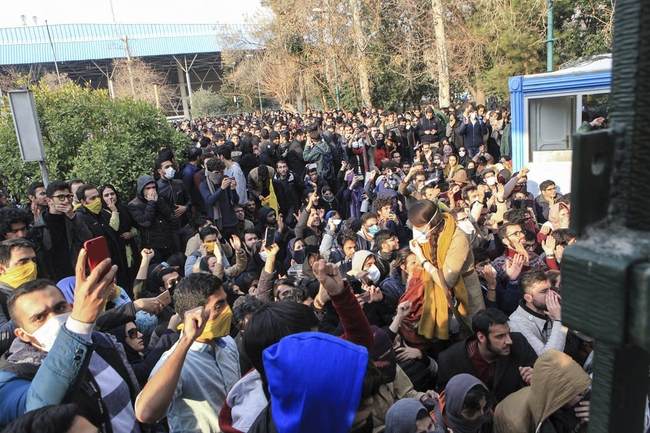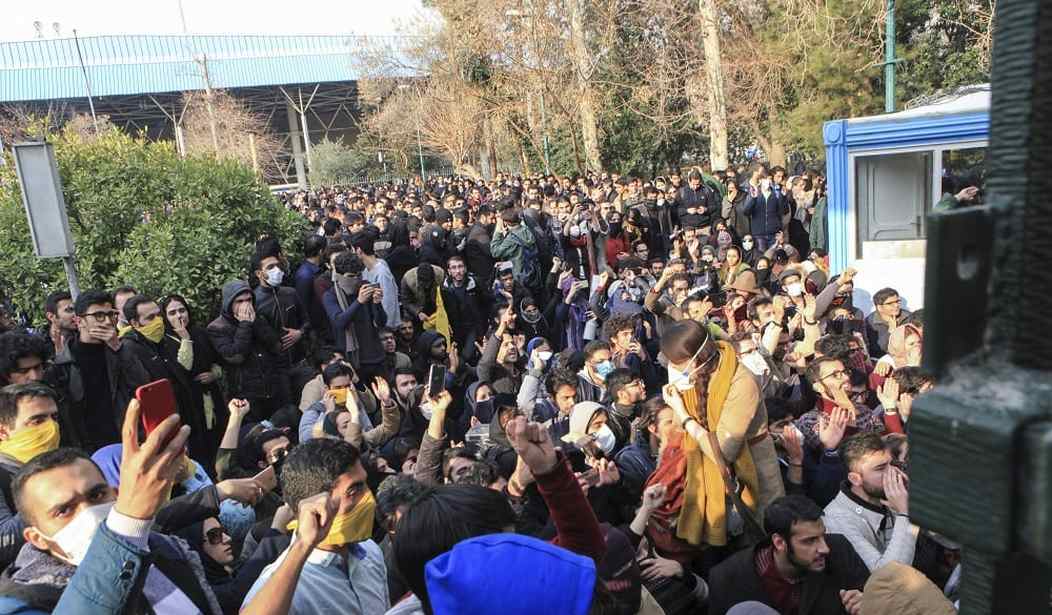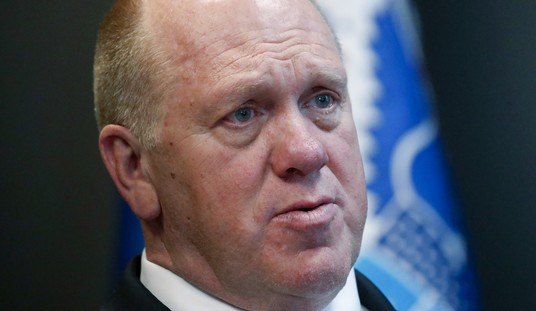
In this photo taken by an individual not employed by the Associated Press and obtained by the AP outside Iran, university students attend a protest inside Tehran University while anti-riot Iranian police prevent them to join other protestors, in Tehran, Iran, Saturday, Dec. 30, 2017. A wave of spontaneous protests over Iran’s weak economy swept into Tehran on Saturday, with college students and others chanting against the government just hours after hard-liners held their own rally in support of the Islamic Republic’s clerical establishment. (AP Photo)
I’m not one of the newly minted internet Iran experts. I have some very tenuous personal connections. I served under a guy who’d been a military adviser to the Iranian Army under the Shah. A friend of mine in college had lived in Tehran when his father was stationed there. I voted for Reagan in no small part because of the Iran hostage crisis. A friend of my girlfriend in Germany was dating a surly, belligerent Iranian guy who has probably blown himself up by now. Beyond that, I know, as Will Rogers said, what I read in the papers. And part of that knowledge is that any American journalist currently reporting from Iran is doing so under a government microscope and so you are getting slightly varnished government propaganda. Another part of that knowledge is that 99% of the sources being used by reporters are the same ones used by the Obama administration to sell the Iran nuclear deal and the rest are former Obama officials. These groups have the same goal: protect Obama’s legacy which seems, increasingly, to be a mix of buffoonishness and criminality.
For instance, the NYT Iran correspondent, Thomas Erdbrink, has just run a story headlined As Iranian Protesters Dig In, Officials Warn of Harsher Response. Its sole purpose seems to be to paint the demonstrators as unreasonable and to make the head mullah, Hassan Rouhani, as a very moderate guy who just can’t understand what is going on:
Ignoring pleas for calm from President Hassan Rouhani, Iranians protesters took to the streets in several cities for the fifth day on Monday as pent-up economic and political frustrations boiled over in the broadest display of discontent in years.
The Iranian government responded with conciliatory words from Mr. Rouhani, but also a widening security clampdown — and a pledge late Monday to crack down even harder.
…
This time, it is the failure of President Rouhani, a moderate, to deliver greater political changes and economic opportunity, despite the lifting of some of the sanctions against Iran as part of the nuclear deal. Young people are especially angry. The average age of those arrested is under 25, one official said.
…
Even the lifting of economic sanctions under Iran’s 2015 nuclear deal with large foreign powers including the United States has not unleashed the growth Mr. Rouhani had hoped for, as key sectors of the economy remain under the thumb of obscure powers, including religious foundations and the country’s Revolutionary Guards. There is mismanagement and widespread corruption in all levels of the state apparatus.Beyond that, the United States has continued other sanctions, making it still harder for Mr. Rouhani to make gains.
The economic frustrations do not appear to have been offset by the greater social freedoms that the president has granted young people. Under Mr. Rouhani, strict Islamic rules have been somewhat relaxed. Concerts have been allowed, and the morals police are largely off the streets. Illegal parties are usually no longer raided, although there have been exceptions.
Indeed, Erdbrink heroically pushes the “economic failure” motive when, if you follow the actual news on Twitter (yes, it is strange to write that) it is very apparent from on the site videos that the economy is merely the last straw.
Which brings me back to my central point: do we know what in the hell is happening there? Obviously, no. When you read from actual Iranians on the ground, people who understand the society and politics, things become very murky. For instance, I transcribed a longish tweetstorm from this guy into paragraph form. Interesting reading.
I think it’s important to look at how #IranProtests are playing out in Iranian media. Coverage and lack thereof can often provide clues as to the broader political significance and even the origins of what’s taking place
1/— Golnar Motevalli (@golnarM) December 31, 2017
I think it’s important to look at how #IranProtests are playing out in Iranian media. Coverage and lack thereof can often provide clues as to the broader political significance and even the origins of what’s taking place. More I had a wee dig at “theory-threads” y’day because seemed people are being barraged by opinions and punditry from far-off locations that aren’t providing nuance or failing, for the sake of brevity, personal politics and pithiness, to speak to the complexity of what’s going on. Not a take or a theory, simply want to highlight some things I’ve in Iran’s domestic media which I think are important to understand both as a reporter and an observer. One thing that was noticeable on Thursday when protests were largely localised to Mashhad, was how clerical establishment in that city, esp leader of Friday prayers, quickly gave a public statement sympathising with the protesters, saying they had “a right” to be disgruntled and he even said that officials (himself included I took him to perhaps mean) ought to be “ashamed” of how the economy had been managed over the past 40 years.
This news was carried on Tasnim and Fars, two of the most-read and followed semi-official news agencies which are seen as allied to hardline and ultra conservative factions that are deeply loyal to the security and religious establishment. This is significant because it shows that the Mashhad protests, whether spontaneous or not, in the very least had the sympathy and support of the hardline conservative establishment, particularly in the city itself. As protests in Mashhad grew, it appeared from videos this wasn’t just about hatred aimed at Rouhani or price of eggs (which is serious, but by all accounts a one-off supply issue driven by avian influenza outbreak). Chants broadened to include the entire state system, including its leadership. At this point the government started to show official reaction. One of the first was 1st VP Jahangiri in a speech in Tehran saying that he understood people had concerns about the economy but that “something else is going on behind the curtain” he then said, addressing whoever it is he thinks that is (ostensibly hardline elements), that “their smoke blew back in their faces”, a Persian way of saying “you shot yourselves in the foot.”
This Jahangiri statement shows a) govt and pro-Rouhanists like himself believe hardliner opposition and state security establishment provoked or even helped organise Mashhad demos and those organisers or “provocateurs” hadn’t factored-in the possibility that the demos would get overtaken by their own opponents calling for their own end. A similar narrative was offered by Akbar Torkan, senior advisor to Rouhani in an interview to the Asr Iran newspaper. He said that these protests, rather than being about the government, its handling of the economy and price rises, were more about the wider political system and the state system, and people are angry and unhappy about that, rather than their elected leaders. Also by Friday, seeing that things were escalating and spreading, both hardline and moderate media started calling the protests “counter revolutionary” … couching them in terms of a seditionist effort to destabilise the Islamic Republic. This chimed with timely anniversary of “9th of Dey” marches, which are organised, pro-state rallies held by the state to mark the point it says it successfully quashed the 2009 protests.
So two competing narratives are at play in terms of how this is being viewed and handled politically here in Iran. In addition to this it’s unclear what the overarching objective of the protests is, there is no clear, single concern that can be distilled like in 2009. I think it’s about broad discontent over disparities in wealth, fairness of access to wealth, expectations on economic recovery not being realised and the country’s approach to social rules and norms.
Final thought, these events may take us by surprise because of the speed with which they appear to happen and their strength/scope, but there’s no vacuum here. People have been angry about the banking and credit industry in Iran, for example, for a long time and the protests earlier this year outside credit institutions, which mushroomed, unauthorised, under Ahmadinejad, issuing millions of dollars in cheap debt to working class Iranians, were a precursor in some ways to what’s happening now.
Ordinary people still can’t fathom how a small minority in Iran managed to get so rich during sanctions and they still feel like they are bearing the downside of that wealth accumulation. They thought the nuclear deal would bring a deeper, broader economic recovery and while it’s helped spur GDP growth, telling that to a man who has three kids, works 2 part-time jobs and drives a Snapp car for five hours during the night, means little. And here oil prices are also at play. Where the government has managed to very successfully revive oil production and exports to former big customers, like the EU, and rejuvenate a key industry and economic driver, oil prices have dampened those revenues going back to Iranian anxieties over the economy, Trump’s policy towards the deal does nothing but fuel this as well as disillusionment at the idea that officials, wherever they are in the world, want to help ordinary people live better lives.
This reads a lot like the Romanian revolution in 1989 that led the Ceaucescus to the firing squad. A power struggle between factions that, like the genie released from the bottle, got a bit out of control and resulted in quite a few clever heads being paraded about on pikes.
Then there is the second part of the equation. Who cares?
The fact is that turmoil, street demonstrations, and general #BLM antics in Iran works to the advantage of just about everyone. It diverts Iran from Iraq and Syria. Without the Iranian link to provide security, Russia is probably out of Syria. Hezbollah is weakened. North Korea loses a major source of foreign currency from its ballistic missile export sales. Iran’s nuclear research grinds to a halt. If the demonstrators succeed. Great. There will social and political turmoil for a period of months if not years. If there is a crackdown, the unrest will grow, grudges will be nursed and it will happen again. Unlike the situation in Libya or Syria where even the dimmest bulb…though not so dim as Susan Rice and Hillary Clinton…could easily see what was going to happen if you overthrew Assad and Qaddafi, what is the worst case outcome in Iran? A hardline, Islamic theocracy that hates America and is hellbent on regional domination and developing nuclear weapons? I think they’ve already taken their best shot at us. Anything we can do to aid the demonstrators is a plus. There is no downside to helping them. Let’s stop worrying about it and get on with the job.












Join the conversation as a VIP Member